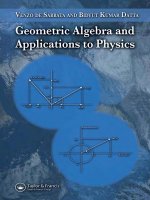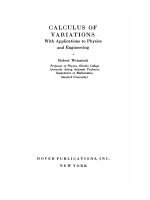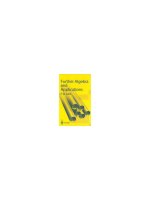- Trang chủ >>
- Khoa Học Tự Nhiên >>
- Vật lý
Geometric Algebra and Applications to Physics doc
Bạn đang xem bản rút gọn của tài liệu. Xem và tải ngay bản đầy đủ của tài liệu tại đây (1.1 MB, 186 trang )
P1: Binaya Dash
November 1, 2006 10:2 C7729 C7729˙C000
Geometric Algebra and
Applications to Physics
P1: Binaya Dash
November 1, 2006 10:2 C7729 C7729˙C000
P1: Binaya Dash
November 1, 2006 10:2 C7729 C7729˙C000
VENZO DE SABBATA
BIDYUT KUMAR DATTA
Geometric Algebra and
Applications to Physics
P1: Binaya Dash
November 1, 2006 10:2 C7729 C7729˙C000
CRC Press
Taylor & Francis Group
6000 Broken Sound Parkway NW, Suite 300
Boca Raton, FL 33487-2742
© 2007 by Taylor & Francis Group, LLC
CRC Press is an imprint of Taylor & Francis Group, an Informa business
No claim to original U.S. Government works
Printed in the United States of America on acid-free paper
10 9 8 7 6 5 4 3 2 1
International Standard Book Number-10: 1-58488-772-9 (Hardcover)
International Standard Book Number-13: 978-1-58488-772-0 (Hardcover)
is book contains information obtained from authentic and highly regarded sources. Reprinted
material is quoted with permission, and sources are indicated. A wide variety of references are
listed. Reasonable efforts have been made to publish reliable data and information, but the author
and the publisher cannot assume responsibility for the validity of all materials or for the conse-
quences of their use.
No part of this book may be reprinted, reproduced, transmitted, or utilized in any form by any
electronic, mechanical, or other means, now known or hereafter invented, including photocopying,
microfilming, and recording, or in any information storage or retrieval system, without written
permission from the publishers.
For permission to photocopy or use material electronically from this work, please access www.
copyright.com ( or contact the Copyright Clearance Center, Inc. (CCC)
222 Rosewood Drive, Danvers, MA 01923, 978-750-8400. CCC is a not-for-profit organization that
provides licenses and registration for a variety of users. For organizations that have been granted a
photocopy license by the CCC, a separate system of payment has been arranged.
Trademark Notice: Product or corporate names may be trademarks or registered trademarks, and
are used only for identification and explanation without intent to infringe.
Library of Congress Cataloging-in-Publication Data
De Sabbata, Venzo.
Geometric algebra and applications to physics / Venzo de Sabbata and Bidyut
Kumar Datta.
p. cm.
Includes bibliographical references and index.
ISBN 1-58488-772-9 (alk. paper)
1. Geometry, Algebraic. 2. Mathematical physics. I. Datta, Bidyut Kumar. II.
Title.
QC20.7.A37D4 2006
530.15’1635 dc22 2006050868
Visit the Taylor & Francis Web site at
and the CRC Press Web site at
P1: Binaya Dash
November 1, 2006 10:2 C7729 C7729˙C000
The authors with Peter Gabriel Bergmann.
From the left: Venzo, Peter, Datta.
P1: Binaya Dash
November 1, 2006 10:2 C7729 C7729˙C000
P1: Binaya Dash
November 1, 2006 10:2 C7729 C7729˙C000
Preface
This is a textbook on geometric algebra with applications to physics and serves
also as an introduction to geometric algebra intended for research workers
in physics who are interested in the study of this modern artefact. As it is
extremely useful for all branches of physical science and very important for
the new frontiers of physics, physicists are very much getting interested in
this modern mathematical formalism.
The mathematical foundation of geometric algebra is based on Hamilton’s
and Grassmann’s works. Clifford then unified their works by showing how
Hamilton’s quaternion algebra could be included in Grassmann’s scheme
through the introduction of a new geometric product. The resulting algebra
is known as Clifford algebra (or geometric algebra) and was introduced to
physics by Hestenes. It is a combination of the algebraic structure of Clifford
algebra and the explicit geometric meaning of its mathematical elements at
its foundation. Formally, it is Clifford algebra endowed with geometrical
information of and physical interpretation to all mathematical elements of
the algebra.
It is the largest possible associative algebra that integrates all algebraic
systems (algebra of complex numbers, matrix algebra, quaternion algebra,
etc.) into a coherent mathematical language. Its potency lies in the fact that it
can be used to develop all branches of theoretical physics envisaging geomet-
rical meaning to all operations and physical interpretation to mathematical
elements. For instance, the spinor theory of rotations and rotational dynamics
can be formulated in a coherent manner with the help of geometric algebra.
One important fact is to develop the problem of rotations in real space-time
in terms of spinors, which are even multivectors of space-time algebra. This
fact is extremely important because it allows us to put tensors and spinors
on the same footing: a necessary thing when we, through torsion, introduce
spin in the general theory of relativity.
This later argument seems to be very important when we will try to con-
sider a quantum theory for gravity. Moreover, the problem of rotations in real
space-time allows us to explain the neutron interferometer experiments in
which we know that a fermion does not return to its initial state by a rotation
of 2π; in fact, it takes a rotation of 4π to restore its state of initial condition.
Geometric algebra provides the most powerful artefact for dealing with
rotations and dilations. It generalizes the role of complex numbers in two
dimensions, and quaternions in three dimensions, to a wider scheme for
dealing with rotations in arbitrary dimensions in a simple and comprehensive
manner.
P1: Binaya Dash
November 1, 2006 10:2 C7729 C7729˙C000
The striking advantage of an entirely “real” formalism of the Dirac equa-
tion in space-time algebra (geometric algebra of “real” space-time) without
using complex numbers is that the internal phase rotations and space-time
rotations are considered in a single unifying frame characterizing them in an
identical manner.
However, other important physical interpretations are based on geometric
algebra as we will show in this book. For instance, geometric algebra (GA)
and electromagnetism, GA and polarization of electromagnetic waves, GA
and the Dirac equation in space-time algebra, GA and quantum gravity, and
also, GA in the case of the Majorana–Weyl equations, to mention only a few.
Venzo de Sabbata
Bidyut Kumar Datta
P1: Binaya Dash
November 1, 2006 10:2 C7729 C7729˙C000
Introduction
There are many competing views of the evolution of physics. Some hold the
perspective that advances in it come through great discoveries that suddenly
open vast new fields of study. Others see a very slow, continuous unfolding
of knowledge, with each step along the path only painstakingly following
its predecessor. Still others see great swings of the pendulum, with interest
moving almost collectively from the original edifice of classical physics to the
20th century dominance of quantum mechanics, and perhaps now back again
towards some intermediate ground held by nonlinear dynamics and theories
of chaos. Superimposed on all of this, of course, is the overriding theme of
unification, which most clearly manifests itself in the quest for a theory that
fully unifies the best descriptions of all the known forces of nature.
However, there is still another kind of evolution of thought and unification
of theory that has quietly yet effectively gone forward over the same scale
of time, and it has been in the very mathematics itself used to describe the
physical attributes of nature. Just as Newton and Leibniz introduced calculus
in order to provide a centralized, rigorous framework for the development
of mechanics, so have many others conceived of and applied ever-refined
mathematical techniques to the needs of advancing physical science. One
such development that is only now beginning to be truly appreciated is the
adaptation by Clifford of Hamilton’s quaternions to Grassmann’s algebraic
theory, which resulted in his creation of a geometric form of algebra. This
powerful approach uses the concepts of bivectors and multivectors to provide
a much simplified means of exploring and describing a wide range of physical
phenomena.
Although several modern authors have done a great deal to introduce
geometric algebra to the scientific community at large, there is still room for
efforts focused on bringing it more into the mainstream of physics pedagogy.
The first steps in that direction were originally taken by David Hestenes who
wrote what have become classic books and papers on the subject. As the
topic gets further incorporated into undergraduate and graduate curricula,
the need arises for the ongoing development of textbooks for use in covering
the material. Among the authors who have recognized this need and acted on
it are Venzo de Sabbata of the University of Bologna and Bidyut Kumar Datta
of Tripura University in India, and the publication of their book Geometric
Algebra and Its Applications to Physics is the satisfying result.
The authors are well known for their research in general relativity. The
roles of torsion and intrinsic spin in gravity have been recurring themes,
especially in the work of de Sabbata, and these topics have played a central
role in the interesting approaches that he, Datta, and others have taken to the
P1: Binaya Dash
November 1, 2006 10:2 C7729 C7729˙C000
quantization of gravity. He has served, since its founding, as the Director of
the International School of Cosmology and Gravitation held every two years
at the Ettore Majorana Centre for Scientific Culture in Erice, Sicily. It has
been at these schools that many of the best general relativists, mathematical
physicists, and experimentalists have explored the interplay between classical
and quantum physics, with emphasis on understanding the role of intrinsic
spin in relativistic theories of gravity. Datta, a mathematician, is a familiar
figure at these schools, and with de Sabbata has published several of the
seminal papers on the application of geometric algebra to general relativity.
The Proceedings of the Erice Schools contain a number of their relevant papers
on this subject, as well as interesting works in the area by others, including
the Cambridge group consisting of Lasenby, Doran, and colleagues.
The book seeks to not only present geometric algebra as a discipline within
mathematical physics in its own right but to show the student how it can be
applied to a large number of fundamental problems in physics, and especially
how it ties to experimental situations. The latter point may be one of the most
interesting and unique features of the book, and it will provide the student
with an important avenue for introducing these powerful mathematical tech-
niques into their research studies.
The structure of Geometric Algebra and Its Applications to Physics is very
straightforward and will lend itself nicely to the needs of the classroom. The
book is divided into two principal parts: the presentation of the mathematical
fundamentals, followed by a guided tour of their use in a number of everyday
physical scenarios.
Part I consists of six chapters. Chapter 1 lays out the essential features of
the postulates and the symbolic framework underlying them, thus providing
the reader with a working knowledge of the language of the subject and
the syntax for manipulation of quantities within it. Chapter 2 then provides
the first look at bivectors, multivectors, and the operators used on and with
them, thus giving the student a working knowledge of the main tools they will
need to develop all subsequent arguments. Chapter 3 eases the reader into
the use of those tools by considering their application in two dimensions, and
it presents the introductory discussion of the spinor. Chapter 4 is devoted to
the extension of those topics into three dimensions, whereas Chapter 5 opens
the door to relativistic geometric algebra by explaining spinor and Lorentz
rotations. Chapter 6 then devotes itself completely to a description of the full
form of the Clifford algebra itself, which combined the work of Hamilton and
Grassmann in its original formulation and was given its modern character by
Hestenes.
Part II of the book then provides the crucial sections on the application
of geometric algebra to everyday situations in physics, as well as providing
examples of how it can be adapted to examine topics at the frontiers.
It opens with Chapter 7, which shows how Maxwell’s equations can be
expressed and manipulated via space-time algebra, using the Minkowski
space-time and the Riemann and Riemann–Cartan manifolds. Chapter 8 then
shows the student how to write the equations for electromagnetic waves
P1: Binaya Dash
November 1, 2006 10:2 C7729 C7729˙C000
within that context, and it demonstrates how geometric algebra reveals their
states of polarization in natural and simple ways. There are two very help-
ful appendices to that chapter: one is on the role of complex numbers in
geometric algebra formulations of electrodynamics and other covers the de-
tails of generating the plane-wave solutions to Maxwell’s equations in this
form. Chapter 9 provides the interface between geometric algebra and quan-
tum theory. Its topics include the Dirac equation, wave functions, and fiber
bundles. With the proper tools in place, the authors then go about using
them to explore the fundamental aspects of intrinsic spin and charge conju-
gation and, their centerpiece, to interpret the phase shift of the neutron as
observed during neutron interferometry experiments carried out in magnetic
fields. It is during the latter discussion that the value of geometric algebra
as applied to experimental findings becomes quite evident. The book ends
with Chapter 10, a return to the original research interests of the authors: the
application of geometric algebra to problems central to the quantization of
gravity. Spin and torsion play key roles here, and the thought emerges that
geometric algebra may well be what is needed to usher in a new paradigm
of analysis that is capable of placing the essential mathematical features of
general relativity on a common setting with those of quantum theory.
As alluded to above, it is somehow very appealing that the great quest for
a unified description of the forces of nature, started by Maxwell, should have
evolved towards its goal over essentially the same period of time that the
mathematical unification embodied by Clifford algebra and its subsequent
evolution took place. This is more than just a serendipitous coincidence, in
that the past 150 years have seen a constant striving for improvements in the
mathematical tools of physics, and the deepest structure of nature itself has
come to be understandable only in terms of the pure mathematics of group
theory and topology. We should not be surprised, then, that the very natural
mathematical synthesis inherent to geometric algebra should cause it to fit
so well with all branches of physics, and we can be grateful to de Sabbata
and Datta for encapsulating this powerful methodology in a contemporary
textbook that should prove useful to generations of students.
George T. Gillies
University of Virginia
Charlottesville, Virginia
P1: Binaya Dash
November 1, 2006 10:2 C7729 C7729˙C000
P1: Binaya Dash
November 1, 2006 10:2 C7729 C7729˙C000
Contents
Part I
1
1 The Basis for Geometric Algebra 3
1.1 Introduction 3
1.2 Genesis of Geometric Algebra 4
1.3 Mathematical Elements of Geometric Algebra 10
1.4 Geometric Algebra as a Symbolic System 13
1.5 Geometric Algebra as an Axiomatic System (Axiom A) 18
1.6 Some Essential Formulas and Definitions 23
References 26
2 Multivectors 27
2.1 Geometric Product of Two Bivectors A and B 27
2.2 Operation of Reversion 29
2.3 Magnitude of a Multivector 30
2.4 Directions and Projections 30
2.5 Angles and Exponential Functions (as Operators) 34
2.6 Exponential Functions of Multivectors 37
References 39
3 Euclidean Plane 41
3.1 The Algebra of Euclidean Plane 41
3.2 Geometric Interpretation of a Bivector of Euclidean Plane 44
3.3 Spinor i-Plane 45
3.3.1 Correspondence between the i-Plane of Vectors
and the Spinor Plane 47
3.4 Distinction between Vector and Spinor Planes 47
3.4.1 Some Observations 49
3.5 The Geometric Algebra of a Plane 50
References 51
4 The Pseudoscalar and Imaginary Unit 53
4.1 The Geometric Algebra of Euclidean 3-Space 53
4.1.1 The Pseudoscalar of E
3
56
4.2 Complex Conjugation 57
Appendix A: Some Important Results 57
References 58
P1: Binaya Dash
November 1, 2006 10:2 C7729 C7729˙C000
5 Real Dirac Algebra 59
5.1 Geometric Significance of the Dirac Matrices γ
µ
59
5.2 Geometric Algebra of Space-Time 60
5.3 Conjugations 64
5.3.1 Conjugate Multivectors (Reversion) 64
5.3.2 Space-Time Conjugation 65
5.3.3 Space Conjugation 65
5.3.4 Hermitian Conjugation 65
5.4 Lorentz Rotations 66
5.5 Spinor Theory of Rotations in Three-Dimensional
Euclidean Space 69
References 72
6 Spinor and Quaternion Algebra 75
6.1 Spinor Algebra: Quaternion Algebra 75
6.2 Vector Algebra 77
6.3 Clifford Algebra: Grand Synthesis of Algebra
of Grassmann and Hamilton and the Geometric
Algebra of Hestenes 78
References 80
Part II 81
7 Maxwell Equations 83
7.1 Maxwell Equations in Minkowski Space-Time 83
7.2 Maxwell Equations in Riemann Space-Time (V
4
Manifold) 85
7.3 Maxwell Equations in Riemann–Cartan
Space-Time (U
4
Manifold) 86
7.4 Maxwell Equations in Terms of Space-Time Algebra (STA) 88
References 91
8 Electromagnetic Field in Space and Time
(Polarization of Electromagnetic Waves) 93
8.1 Electromagnetic (e.m.) Waves and Geometric Algebra 93
8.2 Polarization of Electromagnetic Waves 94
8.3 Quaternion Form of Maxwell Equations from
the Spinor Form of STA 97
8.4 Maxwell Equations in Vector Algebra from
the Quaternion (Spinor) Formalism 99
8.5 Majorana–Weyl Equations from the Quaternion (Spinor)
Formalism of Maxwell Equations 100
Appendix A: Complex Numbers in Electrodynamics 103
Appendix B: Plane-Wave Solutions to Maxwell Equations —
Polarization of e.m. Waves 105
References 107
P1: Binaya Dash
November 1, 2006 10:2 C7729 C7729˙C000
9 General Observations and Generators of Rotations
(Neutron Interferometer Experiment) 109
9.1 Review of Space-Time Algebra (STA) 109
9.1.1 Note 110
9.1.2 Multivectors 111
9.1.3 Reversion 111
9.1.4 Lorentz Rotation R 111
9.1.5 Two Special Classes of Lorentz Rotations: Boosts
and Spatial Rotations 112
9.1.6 Magnitude 112
9.1.7 The Algebra of a Euclidean Plane 113
9.1.8 The Algebra of Euclidean 3-Space 114
9.1.9 The Algebra of Space-Time 116
9.2 The Dirac Equation without Complex Numbers 116
9.3 Observables and the Wave Function 118
9.4 Generators of Rotations in Space-Time: Intrinsic Spin 120
9.4.1 General Observations 121
9.5 Fiber Bundles and Quantum Theory vis-`a-vis the
Geometric Algebra Approach 122
9.6 Fiber Bundle Picture of the Neutron Interferometer
Experiment 122
9.6.1 Multivector Algebra 125
9.6.2 Lorentz Rotations 127
9.6.3 Conclusion 129
9.7 Charge Conjugation 132
Appendix A 133
References 134
10 Quantum Gravity in Real Space-Time
(Commutators and Anticommutators) 137
10.1 Quantum Gravity and Geometric Algebra 137
10.2 Quantum Gravity and Torsion 140
10.3 Quantum Gravity in Real Space-Time 142
10.4 A Quadratic Hamiltonian 146
10.5 Spin Fluctuations 149
10.6 Some Remarks and Conclusions 154
Appendix A: Commutator and Anticommutator 156
References 158
Index 159
P1: Binaya Dash
November 1, 2006 10:2 C7729 C7729˙C000
P1: Binaya Dash
October 24, 2006 14:30 C7729 C7729˙C001
Part I
P1: Binaya Dash
October 24, 2006 14:30 C7729 C7729˙C001
P1: Binaya Dash
October 24, 2006 14:30 C7729 C7729˙C001
1
The Basis for Geometric Algebra
1.1 Introduction
Geometric algebra combines the algebraic structure of Clifford algebra with
the explicit geometric meaning of its mathematical elements at its foundation.
So, formally, it is Clifford algebra endowed with geometrical information
of and physical interpretation to all mathematical elements of the algebra.
This intrusion of geometric consideration into the abstract system of Clifford
algebra has enriched geometric algebra as a powerful mathematical theory.
Geometric algebra is, in fact, the largest possible associative division
algebra that integrates all algebraic systems (viz., algebra of complex num-
bers, vector algebra, matrix algebra, quaternion algebra, etc.) into a coherent
mathematical language that augments the powerful geometric intuition of the
human mind with the precision of an algebraic system. Its potency lies in the
fact that it develops all branches of theoretical physics, envisaging geomet-
rical meaning to all operations and physical interpretation to mathematical
elements, e.g., it integrates the ideas of axial vectors and pseudoscalars with
vectors and scalars at its foundation. The spinor theory of rotations and
rotational dynamics can be formulated in a coherent manner with the help of
geometric algebra.
1. Geometric algebra provides the most powerful artefact for dealing
with rotation and boosts. In fact, it generalizes the role of complex
numbers in two dimensions, and quaternions in three dimensions,
to a wider scheme for tackling rotations in arbitrary dimensions in
a simple and comprehensive manner.
2. The striking advantage of an entirely “real” formulation of the Dirac
equation in space-time algebra (geometric algebra of “real” space–
time) without using complex numbers is that the internal phase
rotations and space–time rotations are considered in a single unify-
ing frame characterizing them in an identical manner.
3. W.K. Clifford synthesized Grassmann’s algebra of extension and
Hamilton’s quaternion algebra by introducing a new type of prod-
uct ab of two proper (non-zero) vectors, called geometric product.
He constructed a powerful algebraic system, now popularly known
3
P1: Binaya Dash
October 24, 2006 14:30 C7729 C7729˙C001
4 Geometric Algebra and Applications to Physics
as Clifford algebra, in which vectors are equipped with a single
associative product that is distributive with respect to addition.
Geometric algebra, developed by Hestenes [1, 2, 3] during the decades
1966–86, though serving as a powerful mathematical language for the devel-
opment of physics, is still not widely known.
1.2 Genesis of Geometric Algebra
An account of the concept of numbers and directed numbers that had been
evolving from antiquity to the 17th century, when symbolism of algebra had
been developed to a degree commensurate with Greek geometry, is given
with full historical background. The deficiencies in the concept of number
in Descartes’ time, however, were removed with the advent of calculus that
gave a clear idea of the “infinitely small.” A transparent idea of “infinity”
and of the “continuum of real numbers” was conceived in the later part of
the 19th century by Weierstrass, Cantor, and Dedekind when real numbers
were defined in terms of natural numbers and their arithmetic without taking
any recourse to geometric intuition of the “linear continuum.” However, the
evolution of the concept of number did not stop here as it would depend more
on the geometric notion than on the linear continuum.
With a proper symbolic expression for direction and dimension came the
broader concept of directed numbers — multivectors — which is a power-
ful mathematical language for physical theories, the sine qua non for future
direction.
Euclid made a systematic formulation of Greek geometry (310
B
.C.) from a
handful of simple assumptions about the nature of physical objects. This, in
fact, provided the first comprehensive theory of the physical world that led
to the foundation for all subsequent advances in physics. In accordance with
Plato’s ideal world of mathematical concepts (360
B.
C.), geometrical figures
were regarded as idealization of physical bodies. The great Greek philosopher
Plato (429–348
B.C.) seems to have foreseen some of the wonderful insights,
such as
1. Mathematics must be studied for its own sake and perceived by
the exercise of mathematical reasoning and insight; its completely
accurate applicability to the objects of the physical world must not
be demanded.
2. Physical theory, on the other hand, could ultimately be developed
and understood only in terms of precise mathematics [4, 5, 6].
The mathematical concepts of Plato’s ideal world were only approximately
realized in terms of the observed features of the physical world we live in.
The central theme of Greek geometry was the theory of congruent figures that
specified a set of rules to be used for classifying bodies with a proper notion
P1: Binaya Dash
October 24, 2006 14:30 C7729 C7729˙C001
The Basis for Geometric Algebra 5
of size and shape. The idea of measurement could have been conceived after
Greek geometry was created, though it was not created with the problem of
measurement in mind.
In this regard we would like to be more precise and question the usual
point of view according to which, in general, Hellenism appears to be a period
of decline [7].
On the contrary, the birth of “modern science” goes back 2000 years,
namely near the end of the 4th century
B.C
. The most known scientists of
that time, Euclid and Archimedes (Euclid with the ability of abstraction of
a thought devoted mostly to philosophical speculations, and Archimedes as
the inventor of burning glass) were not the isolated precursors of a form
of thought that would flourish later on only in the 17th century
A.D. Instead,
they were two of a large group of outstanding scientists: Erofilo of Calcedonia
(around the first half of the 3rd century
B.C.), founder of scientific medicine;
Eratostene of Cirene (around the second half of the 3rd century
B.C.), the
first mathematician who gave a very precise measurement of the length of
the earthly (terrestrial) meridian; Aristarco of Samo (the same epoch of the
3rd century
B.C.), founder of the heliocentric system; Ipparco of Nicea (in the
2nd century
B.C.), precursor of the modern dynamics and gravitation theory;
Ctesibio of Alessandria (first half of the 3rd century
B.C.) who developed the
science of compressible fluids, as well as many others who were protagonists
of a sort of scientific revolution that achieved very high levels of theoretical
elaboration together with experimental practice that was not inferior to that
of Galileo and Newton.
Strangely, the scientists involved in research from the Renaissance period
to date seem to ignore the testimony of this extraordinary phenomenon.
According to Lucio Russo [7], it appears that the Roman people destroyed
the Hellenistic states after the conquest of Syracuse, the killing of Archimedes
(212
B.C.) and the destruction of Corinto (146 B.C.). The indifference of Rome
to scientific culture accounted for most of the original texts being lost.
According to Russo [7], the birth of modern science was not an indepen-
dent or a casual event; “modern” scientists gradually took possession of the
branches of knowledge as they were brought to light by the discovery of the
Greek, Arab, and Byzantine manuscripts.
Euclid sharply distinguished between number and magnitude, associat-
ing the former with the operation of counting and the latter with a line seg-
ment. So, for Euclid, only integers were numbers; even the notion of fractions
as numbers had not yet been conceived of. He represented a whole number n
by a line segment that was n times the chosen unit line segment. However, the
opposite procedure of distinguishing all line segments by labeling them with
numerals representing counting numbers was not possible. Obviously, this
one-way correspondence of counting number with magnitude implies that
the latter concept was more general than the former. The sharp distinction be-
tween counting number and magnitude, made by Euclid, was an impediment
to the development of the concept of number. Even the quadratic equations
whose solutions are not integers or even rational numbers were regarded
P1: Binaya Dash
October 24, 2006 14:30 C7729 C7729˙C001
6 Geometric Algebra and Applications to Physics
to have no solutions at all. The Hindus and Arabs were able to resolve the
problem of generalizing their notion of number by separating the concept
of number from that of geometry. By retaining the rigid distinction between
the two concepts, Euclid expressed problems of arithmetic and algebra into
problems of geometry and solved them for line segments instead of for num-
bers. Thus, he represented the product xx(= x
2
) by a square with each side
of magnitude x, and the product xy by a rectangle with sides of magnitude x
and y. Likewise, x
3
is represented by a cube with each edge of magnitude x,
and xyz by a rectangular parallelepiped with edges of magnitude x, y, and z.
However, there being no corresponding representation x
n
for n > 3inGreek
geometry, the Greek correspondence between algebra and geometry could
not be extended beyond n = 3. This breakdown of Euclid’s procedure of
expressing every algebraic problem into a geometric problem impeded the
development of algebraic methods. These “apparent” limitations of Greek
mathematics were, however, overcome in the 17th century by Ren´e Descartes
(1596–1650) who developed algebra as a symbolic system for representing
geometric notions. This, in fact, led to the understanding of how subtle the
far-reaching significance of Euclid’s work was.
Also, here we would like to stress that the fact that limitation of Greek
mathematics was only apparent and not real is shown by the works of
Pitagora (∼ 585–500
B.C.) after the development of mathematics by Talete
(640–546
B.C.) and their disciples (called “Pythagoreans”). In fact, in Pythagore-
ans one can find a strong correspondence between mathematics (numbers)
and geometry: he and the Pythagoreans have shown that the properties of
numbers (for Pitagora, number means integer number) were evident through
geometric disposition (observe for instance that 1, 4, 9, 16, etc., were called
“squared” numbers because, as points, they can be disposed in squares). The
Pythagoreans were also shocked by the discovery that some ratios (as for
instance the ratio between the hypotenuse and one of the catheti or the ratio
between the diagonal of a square with its side) could not be represented by in-
tegers. They were so shocked that they thought that this should not be brought
to light but must stay secret! It is the first evidence of the presence of numbers
with extra reason (beyond reason), and therefore called “irrational” numbers.
However, what we like to stress is that the correspondence between mathe-
matics (numbers) and geometry was already present in the old Greek science.
After the remarkable development of science and mathematics in ancient
Greece, there was a long scientific incubation until an explosion of scientific
knowledge in the 17th century gave birth to new science, known as
Renaissance science. The long hiatus between the Greek science of antiquity
and Renaissance science can plausibly be explained by its historical evolution.
The evolution of science is determined by its inherent laws. The advances of
the Renaissance had to wait for the development of an adequate number sys-
tem that could express the results of measurement and of a proper formulation
of an algebraic language to express relations among these results. During
this period of scientific incubation the decimal system of Arabic numerals
was invented and a comprehensive algebraic system began to take shape.
P1: Binaya Dash
October 24, 2006 14:30 C7729 C7729˙C001
The Basis for Geometric Algebra 7
In 250
A.D., Diophantes, the last of the great Greek mathematicians, accepted
fractions as numbers. In 1540, Vieta studied rules for manipulating numbers
in an abstract manner by introducing the idea of using letters to represent con-
stants as well as unknowns in algebraic equations. This, in fact, revealed the
dependence of the concept of number on the nature of algebraic operations.
Before Vieta’s innovations, the union of algebra and geometry could not have
been accomplished. This union could have been consummated only when the
concept of number and the symbolism of algebra had been developed to a
degree commensurate with Greek geometry. When the stage of development
in two fronts — the concept of number and the symbolism of algebra — had
just been achieved, Ren´e Descartes appeared on the scene.
Though from the very beginning algebra was associated with geometry,
Descartes first developed it systematically in geometric language. Three steps
are of fundamental importance in this development. First, he assumed that
every line segment could be uniquely represented by a number that endowed
the Greek notion of magnitude a symbolic form. Second, he labeled line seg-
ments by letters representing their numeral lengths. This resided in the fact
that the basic arithmetic operations of addition and subtraction could be de-
scribed in a completely analogous way as geometric operations on line seg-
ments. Third, in order to get rid of the apparent limitations of the Greek rule
for geometric multiplication, he invented a rule for multiplying line segments,
yielding a line segment in complete correspondence with the rule for multi-
plying numbers. By introducing a symbol such as
√
2 to designate a solution
of the equation x
2
= 2, it was possible to recognize the reality of algebraic
numbers. By taking recourse to the above steps, Descartes accomplished the
task of uniting algebra and geometry started by the Greek mathematicians.
Moreover, Descartes was able to use algebraic equations to describe geometric
curves, which heralded the beginning of analytic geometry. Indeed, this was
a crucial step in the development of mathematical language for modern
physics. The assumption of a complete correspondence between numbers
and line segments was the basis of union of algebra and geometry achieved
by Descartes. Pierre de Fermat (1601–1665) independently obtained similar
results. But Descartes penetrated into the heart of the problem by uniting
his concept of number with the Greek notion of geometric magnitude, which
opened up new vistas of scientific knowledge unequalled in the history of the
Renaissance period.
In this context it is quite relevant to note what Descartes wrote to
Mersenne in 1637:
I begin the rules of my algebra with what Vieta
wrote at the very end of his book.
Thus, I begin where he left off.
Vieta used letters to denote numbers, whereas Descartes introduced letters
to denote line segments. Vieta studied rules for manipulating numbers in
an abstract manner, and Descartes accepted the existence of similar rules for
manipulating line segments and greatly improved symbolism and algebraic
P1: Binaya Dash
October 24, 2006 14:30 C7729 C7729˙C001
8 Geometric Algebra and Applications to Physics
technique. Thus, it seemed that numbers might be put into one-to-one
correspondence with points on a geometric line, leading to a significant step
in the evolution of the concept of number.
The deficiencies in the concept of number in Descartes’ time could be felt
with the advent of calculus, which gave a clear idea of the “infinitely small.”
A transparent idea of “infinity” and the “continuum of real numbers” was
conceived in the 19th century by Weierstrass, Cantor, and Dedekind when
real numbers were defined in terms of natural numbers and their arithmetic
without taking any recourse to geometric intuition of the continuum. This
arithmeticization of real numbers, in fact, imparted a precise symbolic
expression to the intuitive concept of a continuous line.
The far-reaching significance of Descartes’ union of number and geometric
length still resides in the fact that real numbers could be put into one-to-one
correspondence with points on a geometric line. The development of algebra
as a symbolic system for representing geometric notions was a great turning
point of Renaissance science. But the evolution of the concept of number did
not stop here, as it would depend more on the geometric notions than on the
linear continuum.
Descartes’ algebra could be used to classify line segments by length only.
The fundamental geometric notion of direction of a line segment finds no
expression in ordinary algebra. The modification of algebra to have a fuller
symbolic representation of geometric notions had to wait some 200 years after
Descartes, when the concept of number was generalized by Herman Grass-
mann to incorporate the geometric notion of direction as well as magnitude.
With a proper symbolic expression for direction and dimension came the
broader concept of directed numbers, now known as multivectors.
We have already mentioned that the theory of congruent figures was the
central theme of Greek geometry. Descartes designated two line segments
by the same positive real number, which we now call the positive scalar, if
one could be obtained from the other by a translation or a rotation or by a
combination of both. Conversely, every positive scalar was represented by
a line segment without any restriction to its position and direction, i.e., all
congruent line segments were regarded as one and the same.
In order to conceive of the idea of directed number, Herman Grassmann
generalized the concept of number by incorporating the geometric notion of
both direction and magnitude in his book Algebra of Extension in 1844. He
invented a rule for relating directed line segments to numbers. In contrast to
Descartes’ idea, he regarded two line segments as equivalent and designated
them by the same symbol, if and only if one could be obtained from the other
by a translation. On the other hand, he regarded two line segments as pos-
sessing different directions and designated them by different symbols, if and
only if one can be obtained from the other by a rotation or by a combination of
translation and rotation. Thus, Grassmann conceived of the idea of directed
line segment or directed number, called vector. A vector is graphically repre-
sented by a directed line segment and embodies the essential abstractions of
magnitude and direction without any restriction to its position.









